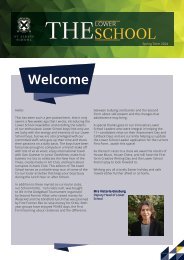Create successful ePaper yourself
Turn your PDF publications into a flip-book with our unique Google optimized e-Paper software.
68<br />
Abacuses were something of a new invention,<br />
but, when they were used, an empty<br />
space was left to indicate that there was<br />
nothing to add on. So, we ca<br />
n tell that these primitive people did have<br />
an idea of the concept zero, but al-<br />
Khwarizmi was the one who actually gave<br />
it a name. He then took it one step further<br />
and expanded upon the idea of early algebra,<br />
allowing more complex calculations<br />
to be performed, with the aid of his newfound<br />
number. Although al-Khwarizmi<br />
lived less than 40 years, his legacy is still<br />
felt today, testament to the rapid mathematical<br />
discovery that has taken place<br />
since his death, so this development is<br />
naturally credited to him.<br />
Whilst mathematical progress was being<br />
made from al-Khwarizmi’s death onwards,<br />
much of it<br />
was simply expanding<br />
on what<br />
earlier mathematicians<br />
had discovered<br />
and<br />
there were very<br />
few new concepts<br />
produced.<br />
We do not see a<br />
significant discovery again until 1614 (as<br />
between then and Al-Khwarizmi’s death,<br />
the<br />
most that occurred was further development<br />
of algebra, as well as the decimal<br />
system being introduced). This discovery<br />
was made by John Napier of Scotland,<br />
who revolutionised the mathematical<br />
world once again with the concept of Logarithms.<br />
A logarithm (or ‘log) is similar to<br />
an index (for example, a to the power of b<br />
where a and b are both integers), except<br />
that they are used to express numbers of<br />
powers of ten. For example, the number<br />
100 is equal to 10 squared, which means<br />
that the logarithm of 10 here is 2. <strong>The</strong>se<br />
logarithms may be developed into logarithmic<br />
tables, which are particularly useful<br />
for working out things like<br />
trigonometric functions, something with<br />
great significance and importance today.<br />
“All the way from the development of<br />
zero, right up to the pioneering Chaos<br />
theory, we know that maths is the<br />
driving force behind the world”<br />
<strong>The</strong> final stop on our mathematical tour is<br />
in the early 19 th and 20th centuries, when<br />
we experience a boom of new ideas, after<br />
a somewhat stagnant period of mere expansions<br />
of existing knowledge. Kickstarted<br />
somewhat by the Industrial Revolution,<br />
where new ideas were widespread<br />
thanks to the necessity of moving industrial<br />
materials. Where one thing moves,<br />
ideas usually move with it. In 1830, we see<br />
the development of non-Euclidian geometry;<br />
then, during the mid-20 th century, we<br />
see the pioneer, Benoit Mandlebrot develop<br />
fractal geometry. But the pinnacle of<br />
this boom was without doubt Chaos <strong>The</strong>ory.<br />
Chaos theory states that where we see<br />
great randomness, such as in weather systems,<br />
there is actually<br />
great underlying<br />
complexity<br />
and selforganization.<br />
Such is true for<br />
weather systems,<br />
although Chaos<br />
theory was not<br />
applied to<br />
weather systems until the 21 st Century.<br />
This is such an incredible concept because<br />
it proves that maths is omnipotent. If you<br />
look out of the window and a gale is<br />
blowing, rain whipping the windows,<br />
there is order in the black heart of the<br />
storm. <strong>The</strong>re is method in the madness.<br />
Maths really is everywhere; in everything<br />
we see and in everything we do. It is incredible<br />
to think that this all came from a<br />
wolf’s femur found buried in the Czech<br />
Republic from 10 000 years ago! All the<br />
way from the development of zero, right<br />
up to the pioneering of Chaos theory, we<br />
know that maths is the driving force behind<br />
the world. It’s in this paper. It’s in<br />
this page. It’s even in you.<br />
Ben, 4.2


















